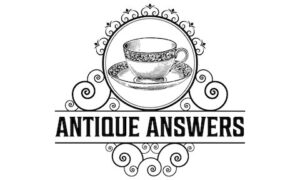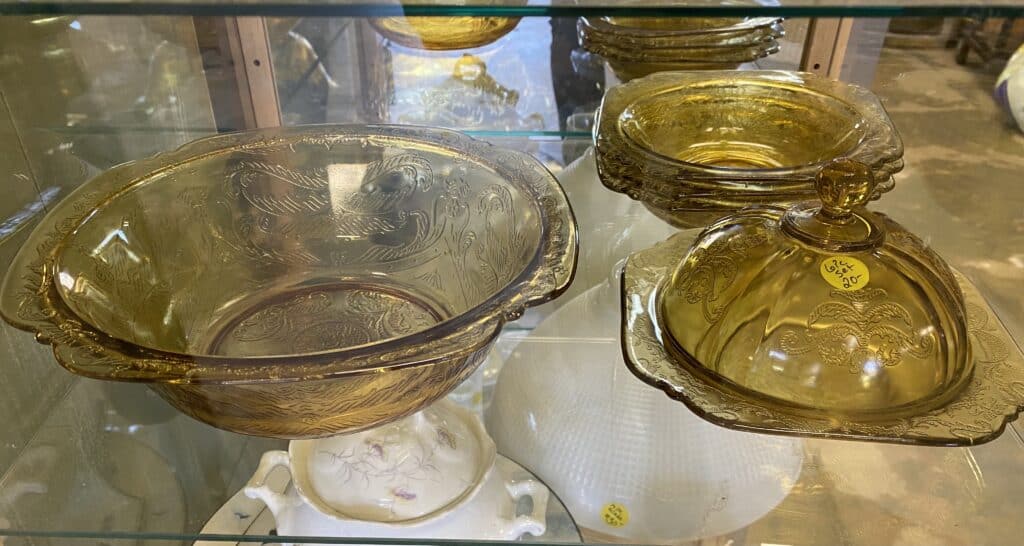
The Federal Glass Company began in 1900 and produced glassware until 1979. Federal Glass was most popular in the Great Depression Era of the late 1920s through the early 1940s. The company produced many patterns of “Depression Glass” in multiple colors during that time.
This article includes the most popular Federal Glass Depression Glass patterns and colors, as well as images of each pattern.
The Federal Glass Depression Era patterns are:
- Pebble Optic – aka Raindrops
- Thumbprint
- Colonial Fluted – aka Rope
- Spiral / Twisted Optic / Corded Optic
- Sylvan – aka Parrot
- Georgian – aka Lovebirds
- Madrid
- Patrician – aka Spoke
- Normandie
- Mayfair
- Rosemary – aka Dutch Rose
- Sharon – aka Cabbage Rose
- Diana
- Columbia
Learning the patterns and colors will enable you to identify if a Depression Glass item is Federal Glass, as not all of their pieces were marked with their maker’s mark of a capital “F” in a shield outline.
Federal Glass Company Depression Glass Patterns and Colors
Pebble Optic “Raindrops” (1927 – 1933)
Pebble Optic or “Raindrop” pattern was one of the earliest Depression Glass patterns produced by Federal Glass Company or any glass company for that matter. Federal began producing this in 1927, technically before the Great Depression began.
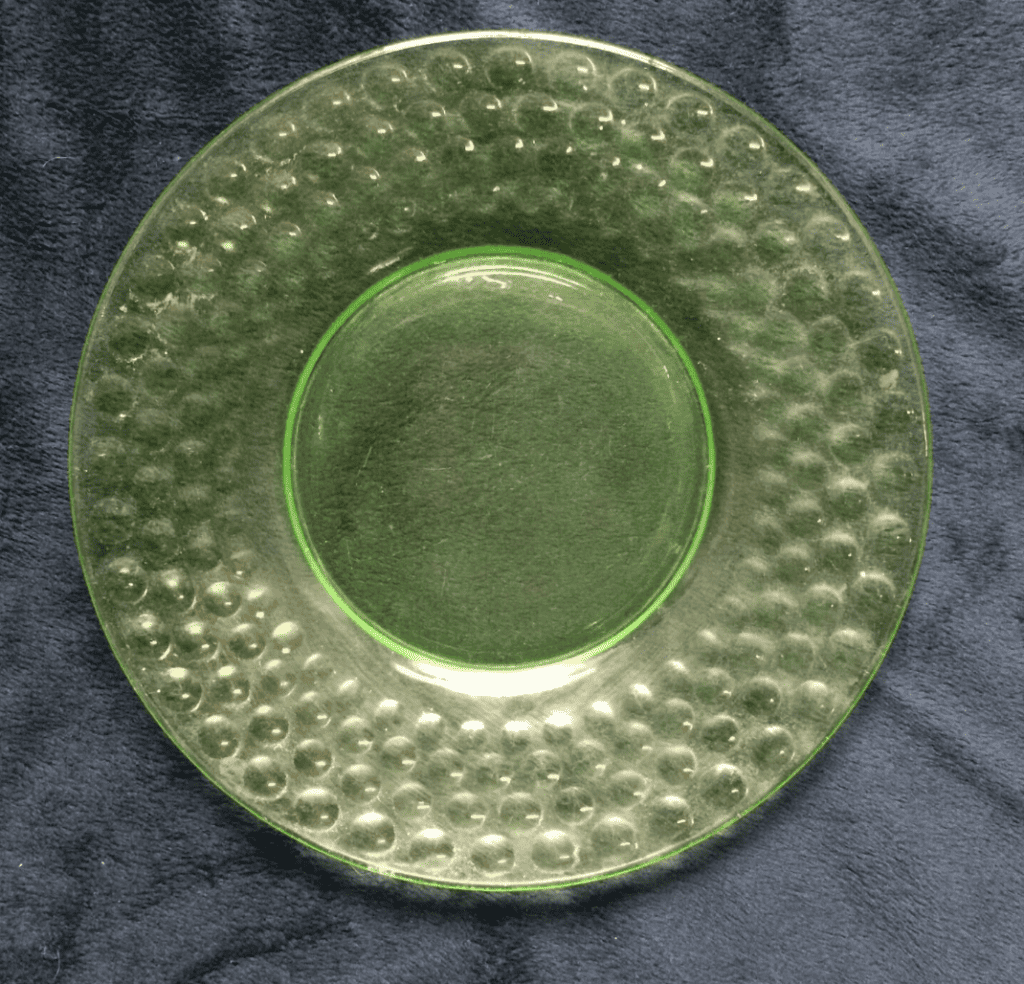
Pebble Optic was made mainly in green, although there are some crystal (clear) items. Bowls, cups, plates, etc were produced in this pattern, and notably there were 7 different sizes of tumblers available! This is reflective of the Prohibition era in which they were made.
Thumbprint (1927 – 1930)
Notice the similarity of Federal’s Thumbprint pattern versus the Raindrop (Pebble Optic) pattern above. Thumbprint “dents” are oval in shape whereas the Raindrop “dents” are round. Thumbprint was also mainly produced in green, but some crystal (clear) pieces do exist.
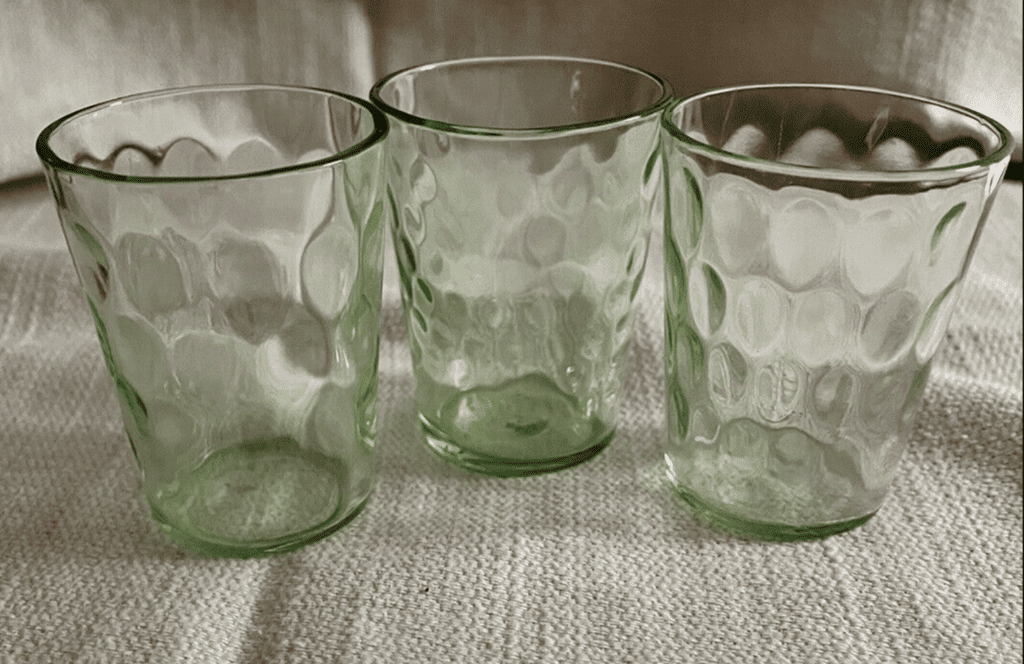
Colonial Fluted “Rope” (1928-1933)
Colonial Fluted, also called “Rope” patterned pieces were offered mainly in green and crystal (clear), and possibly pink (unconfirmed). As with most green glass at the time, this pattern in green did contain uranium and therefore these green pieces will glow.
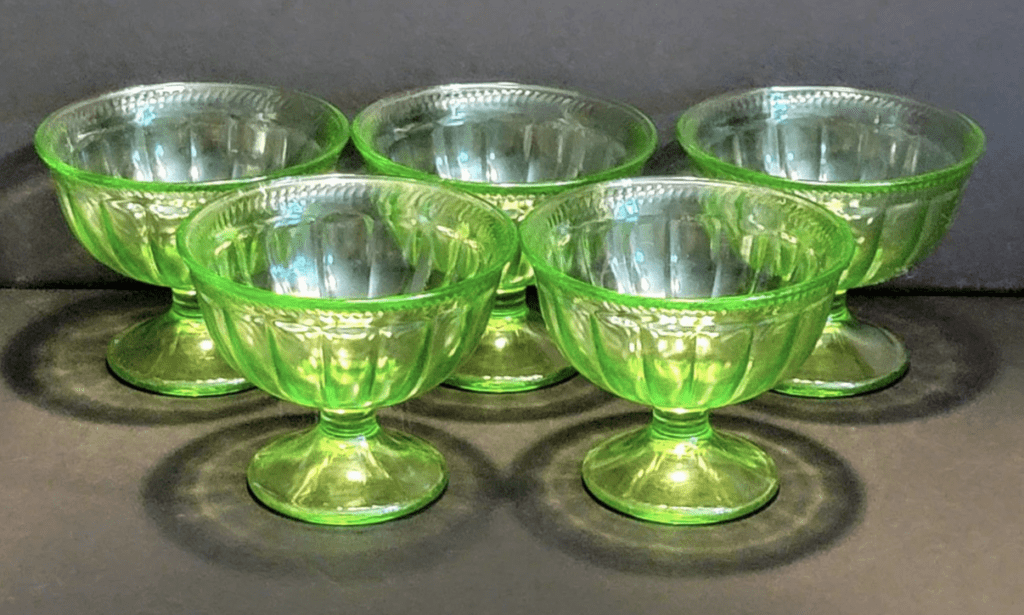
There were only a handful of items made in this pattern such as bowls, 8″ luncheon plates, handled cups with saucers, sugar (with lid) and creamer, and sherbet dishes with a 6″ sherbet plate.
Mauzy’s Guide states that in 1930, Federal created a specialized Colonial Fluted pattern called “The Bridgette Set” by decorating this patterned glass with enameled hearts, diamonds, clubs, and spades. However, I’ve been unable to locate any additional information or photographs for this pattern.
Spiral (1928 – 1933) – Corded Opctic – Twisted Optic
Spiral was another one of the earlier Depression Glass patterns produced by Federal Glass Company. Spiral was produced in pink, green, and clear, although the green was the most common.
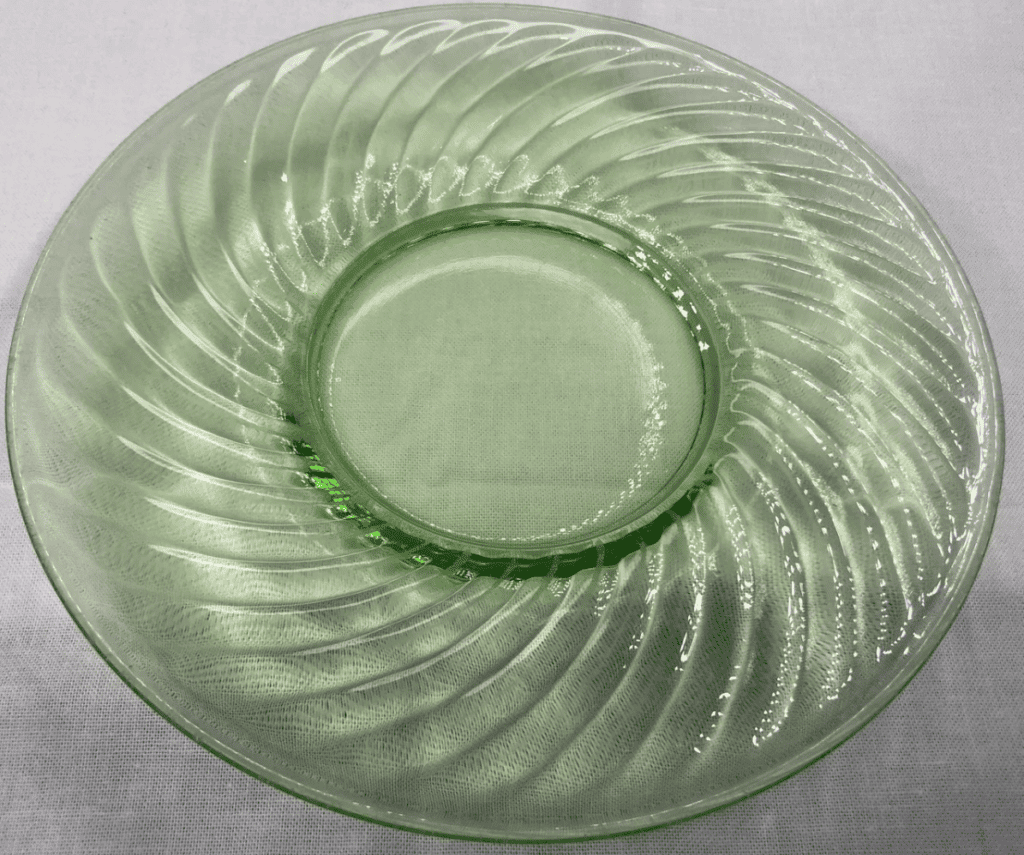
Pitcher and tumbler sets can be found in green under the name “Corded Optic”, which is also a swirl pattern, but different from the “Spiral” set. A set that includes the pitcher and 4 or more tumblers tends to sell for $100-$200, making these some of the more valuable depression-era Federal Glass sets.
Occasionally the Corded Optic pattern tumbler and pitcher gets mislabeled as Diana pattern, however, a pitcher was not produced in Diana pattern, and the only Diana tumbler is 4 inches tall and does not have the spiral pattern throughout. (See below the image of the Corded Optic pitcher and tumblers and compare to the Diana tumblers in the Diana section of this article).

The National Depression Glass Association (NDGA) does not list a spiral pattern during the depression era produced by Federal Glass Company. However, Spiral is included in Mauzy’s Depression Glass Guide as well as a great book about the history of the Federal Glass Company called “Shield F“. This book shows Federal Glass advertisements from 1928 and 1929 that show tumblers in “Corded Optic” pattern and goblets in “Twisted Optic” pattern.
See below the Federal Glass “Twisted Optic” goblet, which does include the maker’s mark of the F inside a shield. As with most green glass produced during the depression era, these were made with uranium and therefore glow under the black light.
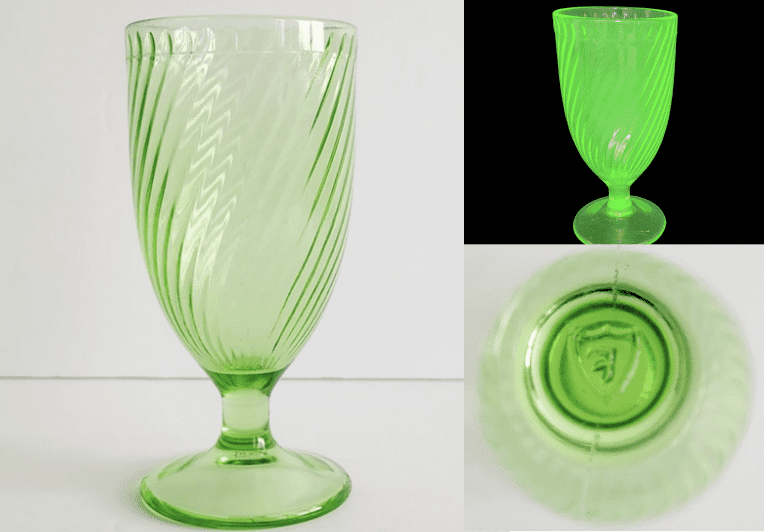
Most of the other big glass companies were producing a swirling type pattern at this time, and it can be difficult to tell them apart if they are unmarked. For example, Hazel Atlas produced a nearly identical goblet to the one pictured above in Twisted Optic, and their spiral patterned 8″ plates are very similar to Federal’s Spiral plates.
Here are the other Depression Glass patterns that were a swirl or spiral:
- Twisted Optic by Imperial Glass
- U.S. Swirl by U.S. Glass Company
- Spiral and Banded Spiral by Hocking Glass Company
- Spiral Optic by Jeannette Glass Company
- Spiral by Hazel-Atlas Glass Company
- Spiral Optic by Fostoria Glass Company
- Spiral Optic by Indiana Glass Company
- Spiral Optic by Tiffin Glass Company
- Diana by Federal Glass Company
So as you can see, there are MANY spiral-patterned Depression Glass dishes floating around, making it very difficult to determine which company produced them.
Other Optic Tumblers (1927 – ?)
The book “Shield F” mentions that tumblers were made in other “optic” patterns in addition to Corded Optic and Twisted Optic. These include Diamond Optic, Pear Optic, and Polka Dot Optic. Though not mentioned in this book, I have come across references to a Hexagon Optic pattern as well as a Panel Optic pattern by Federal Glass. I have not been able to confirm these patterns with their appearance from any reference guide. Please contact me if you have more information on these!
Sylvan “Parrot” (1931 – 1932)
The most rare and therefore most valuable Federal Glass pattern is the “Sylvan” pattern, also known as the parrot pattern. This glassware features 3 parrots sitting on branches with tree leaves. Don’t confuse this with the other bird pattern produced by Federal Glass, “Georgian” or lovebirds.
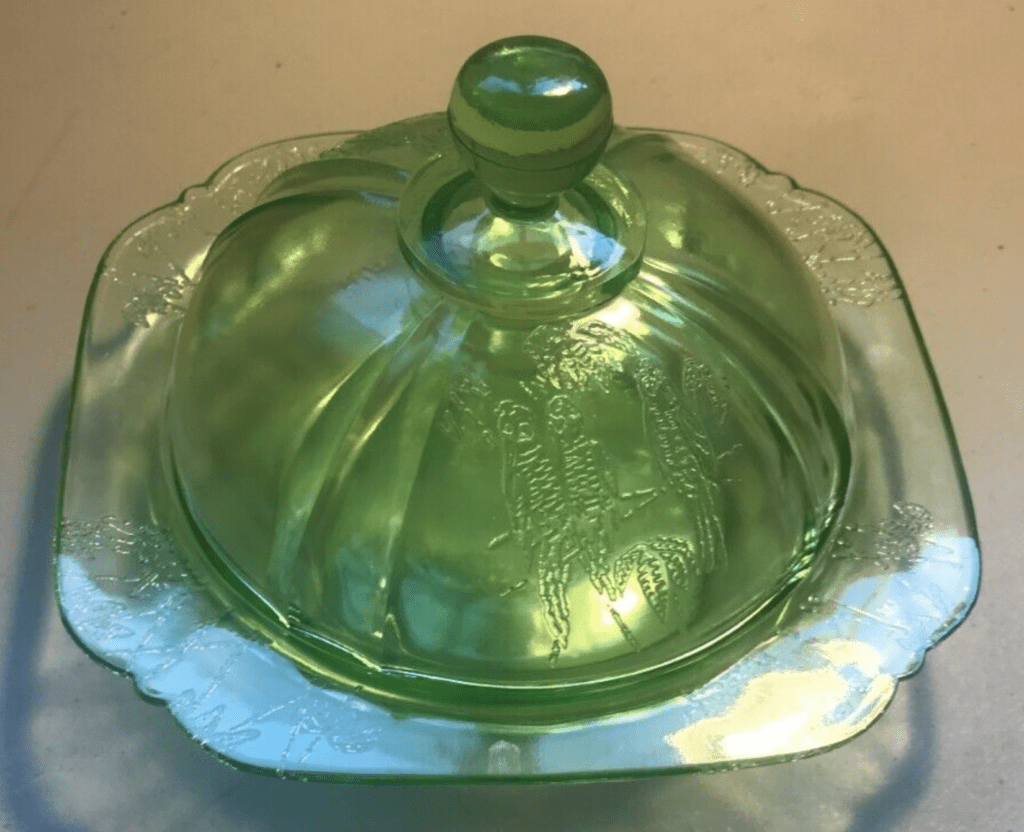
The parrot pattern was only produced for 2 years and was made in green and amber, though Mauzy’s Guide states that there was a blue sherbet dish made in this pattern as well as a crystal (clear) square grill plate.
Though not all the pieces in the Sylvan pattern are extremely valuable, certain items such as pitchers, hot plates, and tumbler sets have sold for several hundred dollars up to $3,500! Check out Worthpoint to get the most recent selling prices.
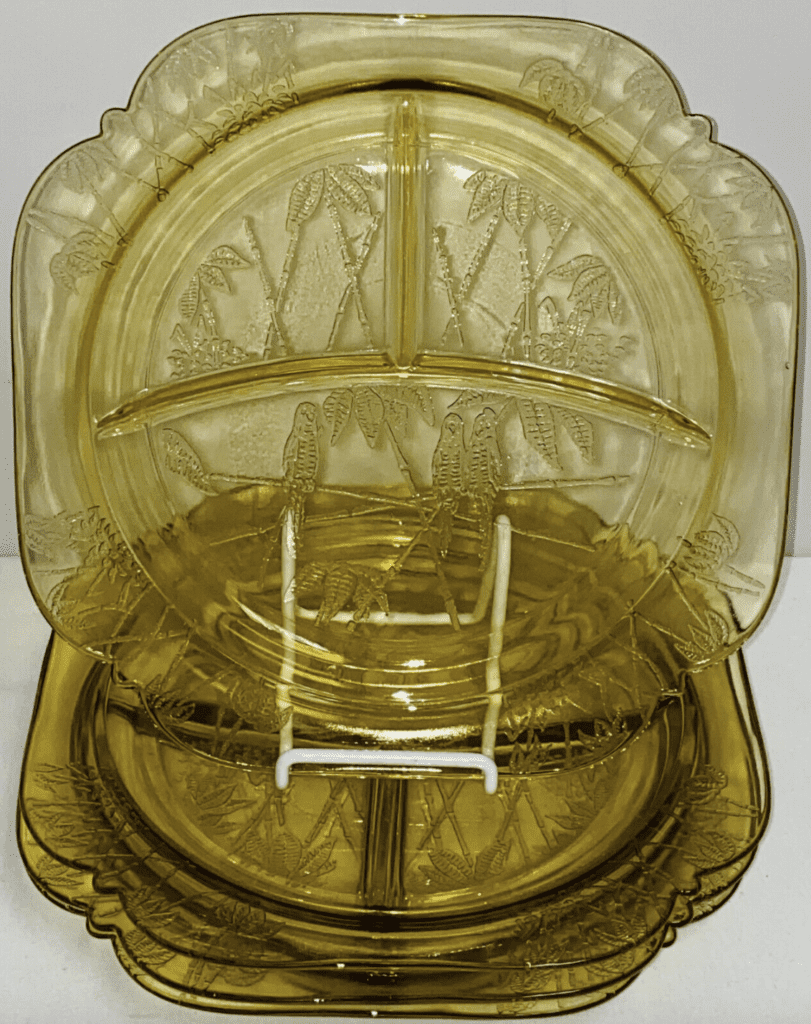
One final note, do not confuse this pattern with the “Indiana Parrot” pattern that was produced by the Indiana Glass Company.
Georgian – “Lovebirds” (1931 – 1935)
The Georgian pattern is one of the most popular patterns that Federal Glass Company made, and was one of their higher-priced patterns. It typically came in green, but some reference books state that a few pieces were made in crystal (clear) and amber. Many pieces of tableware and serving items were made in this pattern.
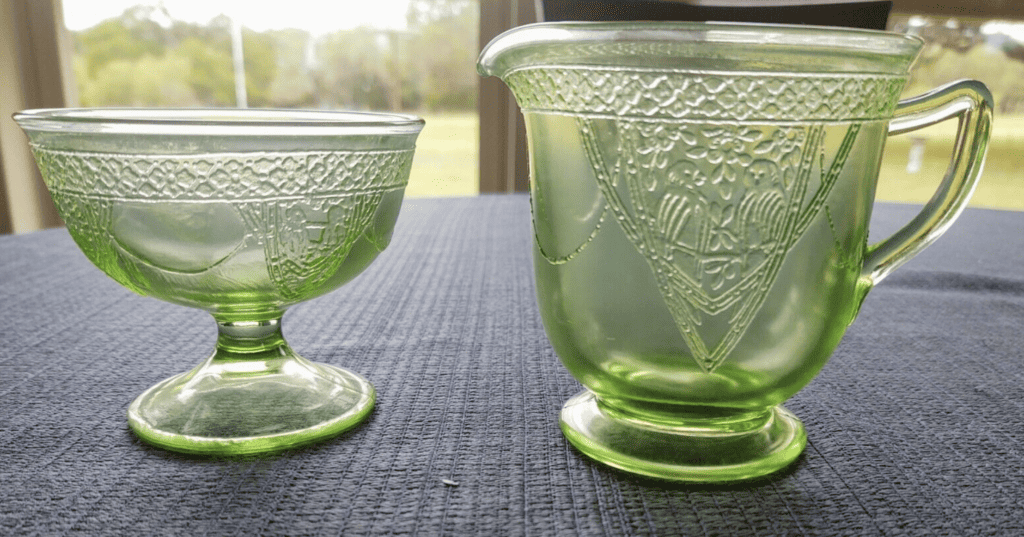
The Georgian pattern consists of rounded triangle cartouches framing two birds alternating baskets. The triangles are connected by draping greenery and each center has a medallion-like design. Because of the birds in this pattern, it has also been dubbed as the “Lovebird” pattern.
Madrid (1932 – 1938)
The Madrid pattern was originally made or found on glassware such as dinner plates, cups and saucers, grill plates, and a few others. The pattern itself seems to look almost paisley-like in design. The Madrid pattern comes in the colors of amber yellow, pink, blue, green, and crystal (clear) glassware.
Federal Glass Company offered many different pieces in this pattern, everything from ash trays to plates and bowls to gravy boats and jello molds!
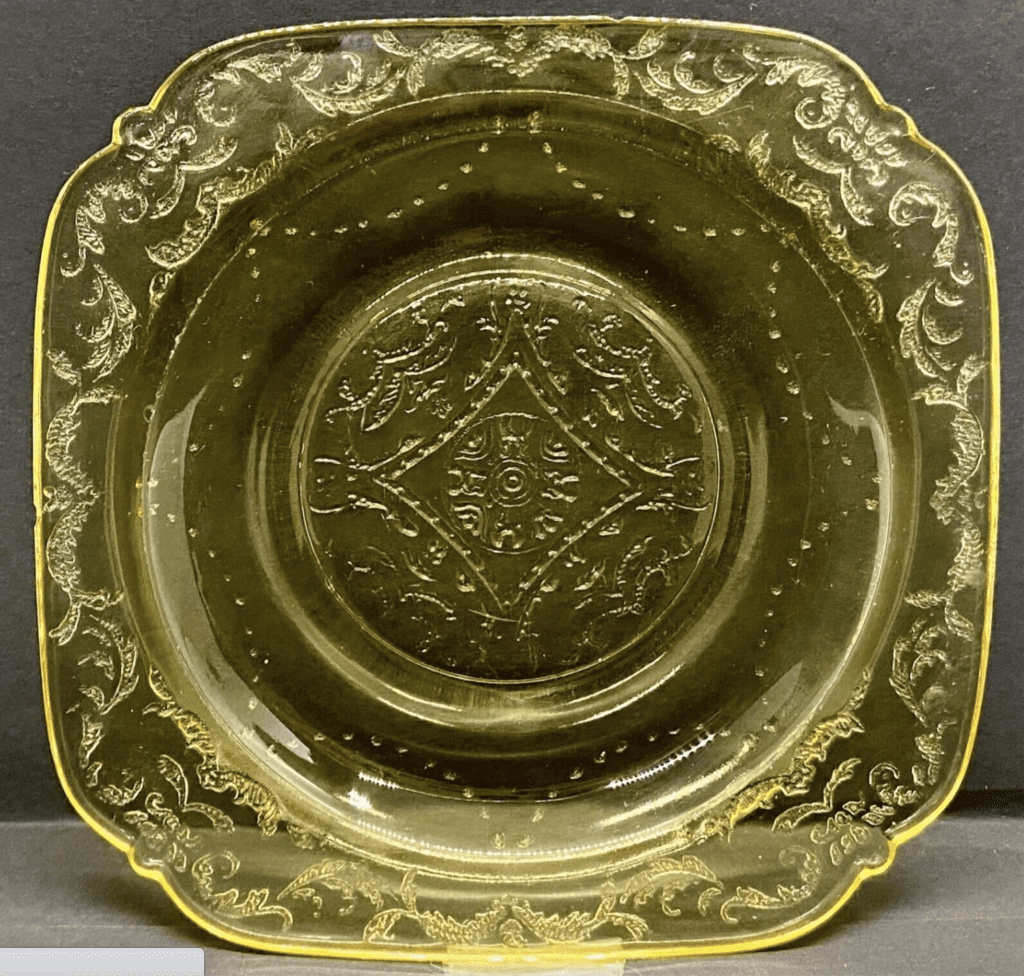
Note that with the Madrid pattern, Indiana Glass Company bought the molds when Federal Glass went bankrupt, and they did continue to produce this pattern, naming it “Recollection.” It may be difficult to determine whether a Madrid pattern item is an original vintage Federal Glass Company item or if it was produced by Indiana Glass Company. Check out this article to help determine the difference.
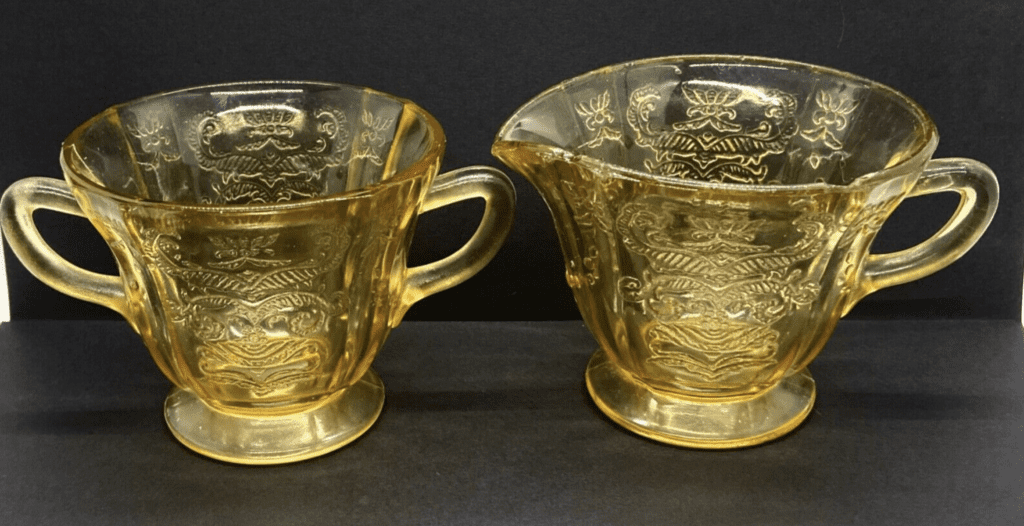
Personally, I have found amber Madrid pieces to be the pattern and color of Federal Glass that I come across the most in local thrift and antique stores.
Patrician “Spoke” (1933 – 1937)
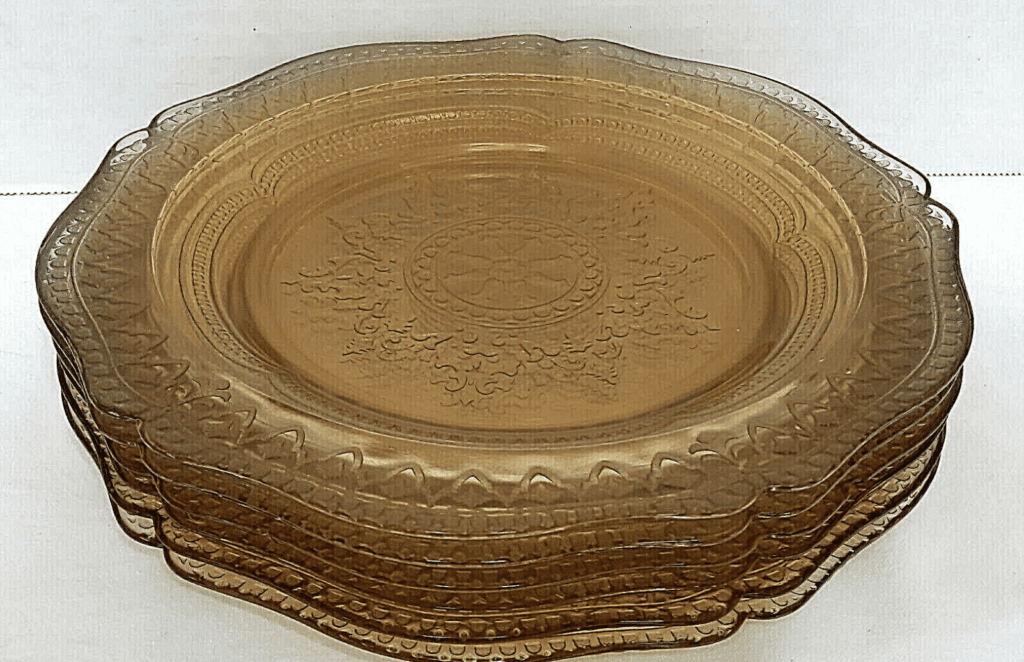
Patrician is most commonly found in amber or “Golden Glow”, but it was also produced in green, pink, and crystal (clear). This pattern is still decently popular with collectors, and I’ve come across pieces of Patrician pattern multiple times in local antique stores.
The cookie jar in this pattern regularly sells for $375-$525, so take note if you ever come across one!
Normandie – “Bouquet and Lattice” (1933 – 1939)
The Normandie pattern is the only depression-era glassware that can be found with an iridescent shine to it. It can typically be found in an iridescent color known as ‘sunburst’. It came in non-iridescent colors such as amber and pink, although these colors are harder to find, especially if you’re looking for specific dinnerware objects in one of these shades.
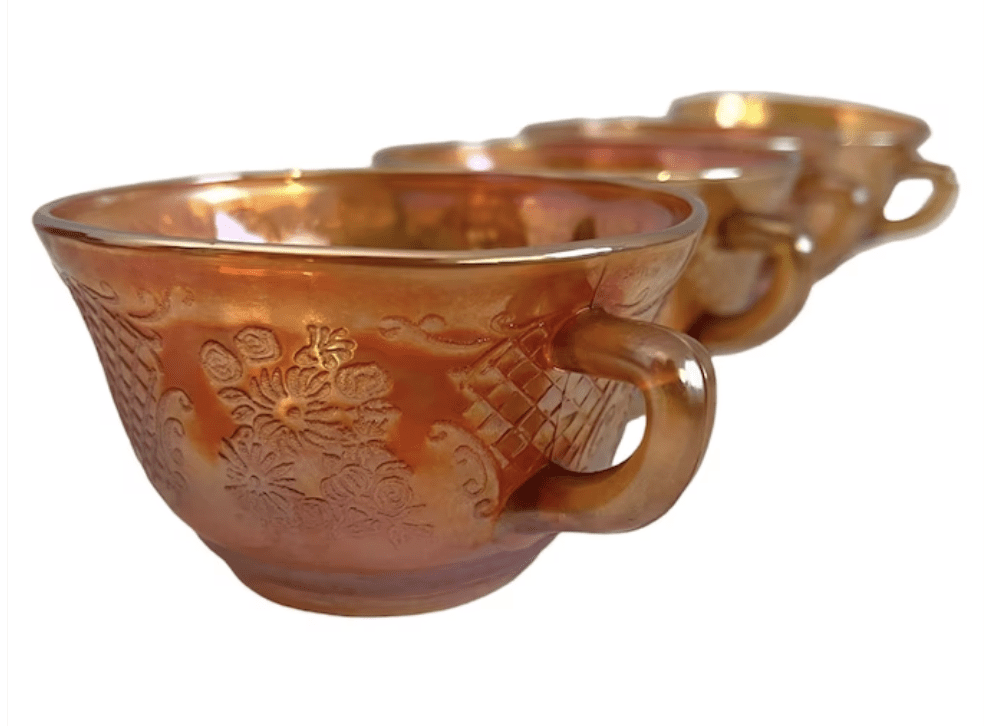
The pattern is an intricate lattice with some side floral design, which is only enhanced by the color it can be found in. Due to its pattern, it is also commonly known as the “Bouquet and Lattice” pattern. The Normandie pattern doesn’t have as wide a variety of pieces – especially in the decorative area – as some of the other patterns do. However, it can be found available on dinner plates, grill plates, cups and saucers, pitchers, and a few other dinnerware objects.
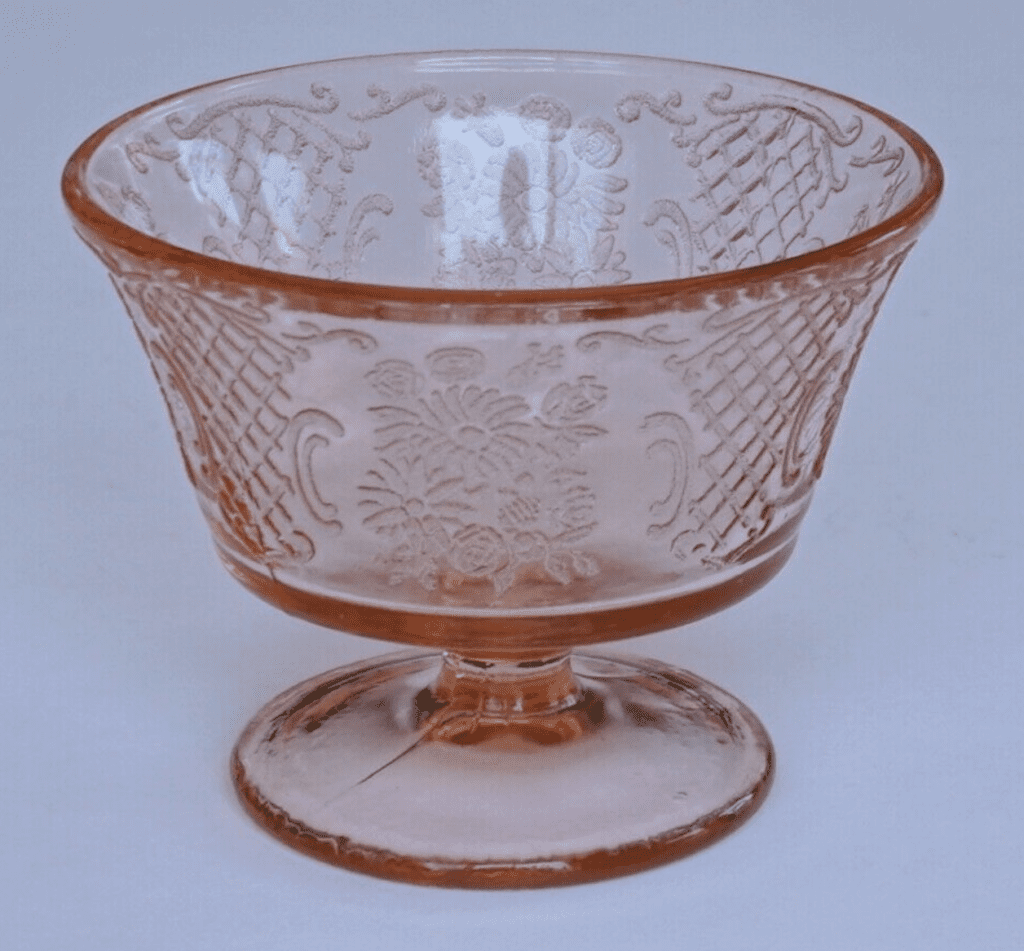
Mayfair (1934)
Mayfair was only produced by Federal Glass Company in 1934. Hocking Glass Company was also producing a glass pattern under the name Mayfair (also known as “Open Rose”), and as you can imagine, this caused some confusion and conflict.
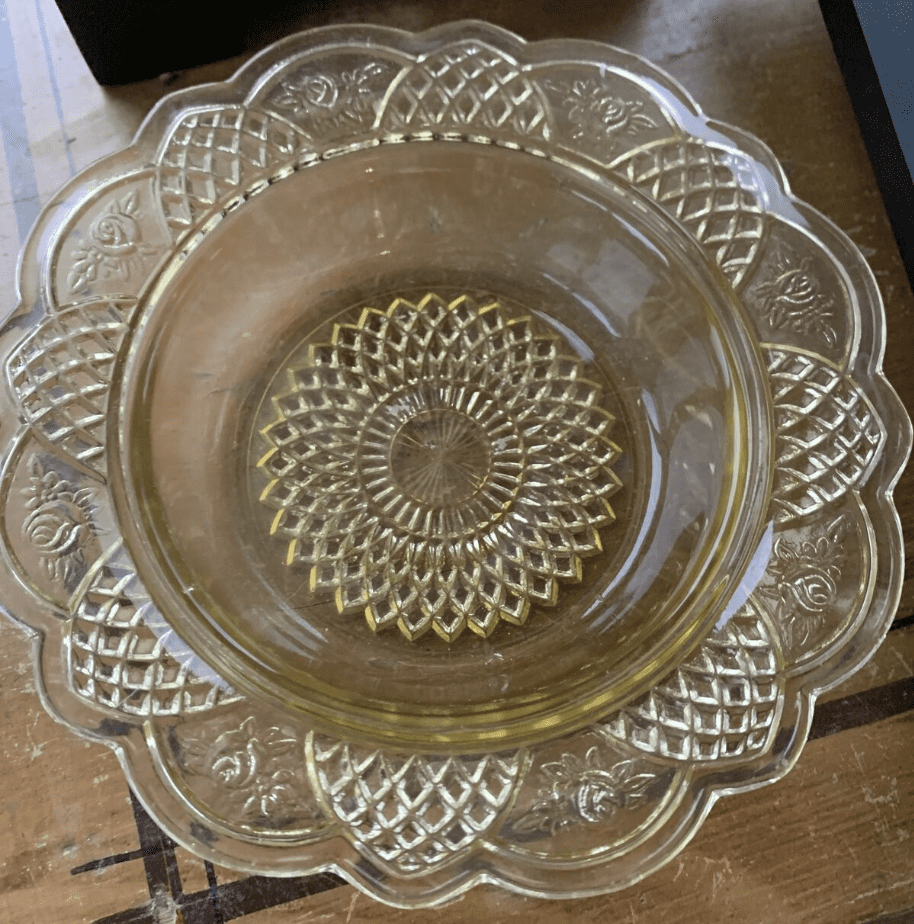
The Mayfair pattern involves arched panels alternating with a pair of open roses inside or a honeycomb pattern, giving it the look of almost being like a Cathedral stained glass window design. Federal Glass offered this pattern in “Golden Glow” (amber yellow), crystal (clear), and green.
The Mayfair pattern soon evolved into the Rosemary pattern, which is also known as “Dutch Rose”. Then, both Mayfair pattern and Rosemary pattern gave way to “Sharon” or “Cabbage Rose” pattern.
Rosemary – “Dutch Rose” (1935 – 1936)
The Rosemary kept the pattern of arches and roses of Mayfair, however, it did not have the honeycomb pattern.
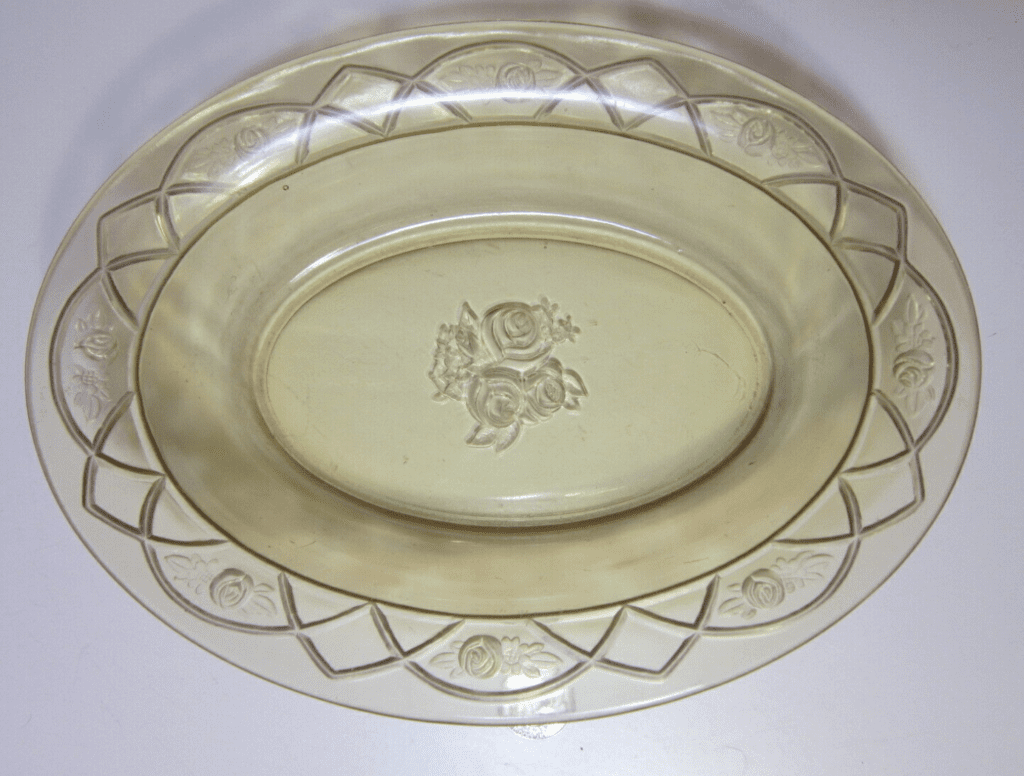
This pattern can mostly be found in “Golden Glow” (amber), but there are rare colors of “Springtime Green” and “Rose Glow” (pink). Both the Mayfair and the Rosemary pattern only came available in 13 pieces such as dinner plates, a small berry bowl, as well as a few serving pieces.
Sharon “Cabbage Rose” (1935 – 1939)
The Sharon pattern, also known as “Cabbage Rose”, was one of the most popular Federal Depression Glass patterns. It was produced in pink, green, amber and crystal, but pink was most popular. If you see Sharon pattern in blue or jadeite, these are reproductions or fakes.
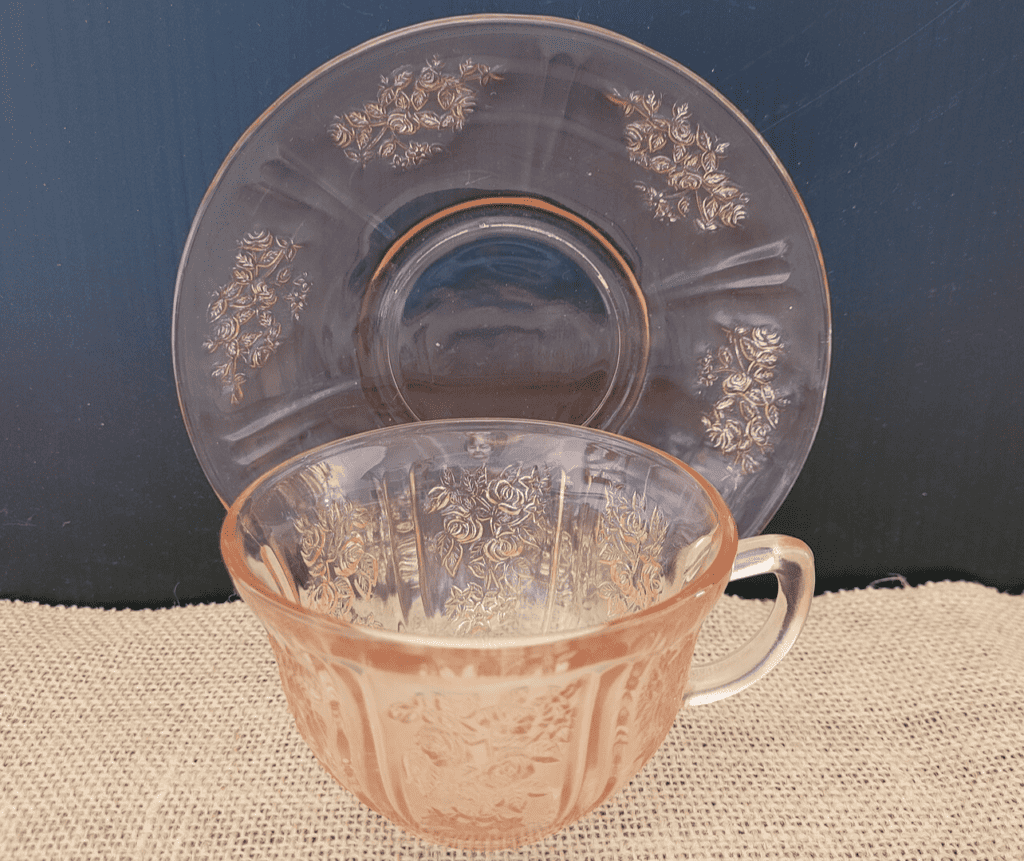
Several Sharon patterned covered butter dishes and cheese dishes in pink have sold in the past few years for over $1,000 on Ebay. Mauzy’s notes that the lid for the cheese dish and butter dish are actually the same lid.
Diana (1937 – 1941)
Diana is another of Federal Glass Company’s “swirled” Depression Glass patterns. This pattern is most often seen in pink, amber, and crystal (clear). However, Diana pattern can also be found in limited items in green, red, frosted with red trim, and clear tumblers that sometimes included colored stripes around the top.
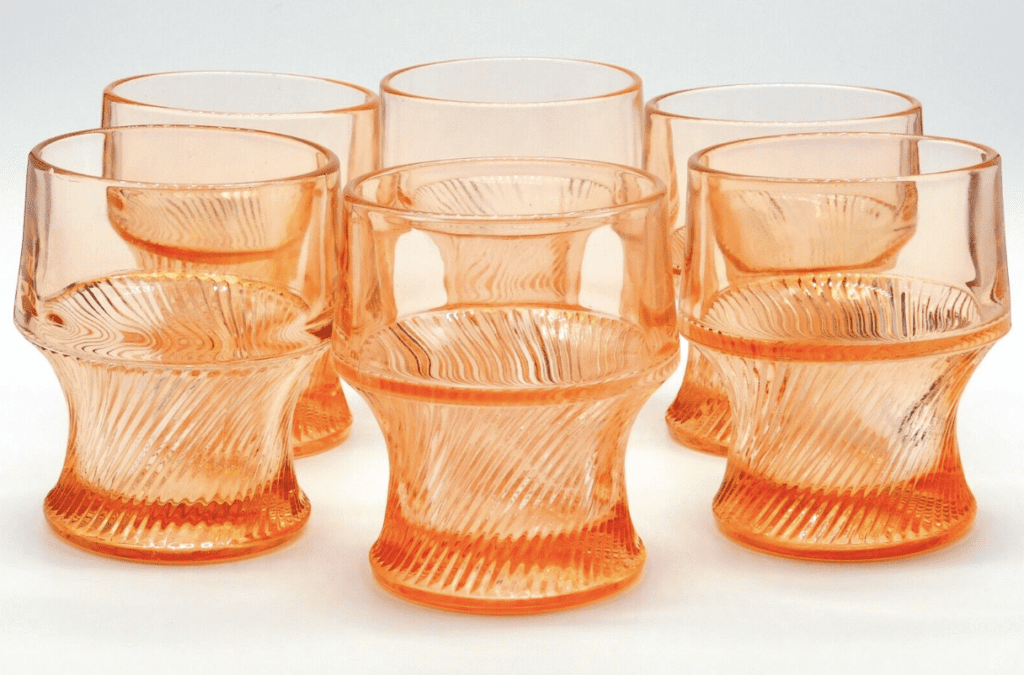
The Diana pattern is one of the few geometric patterns that the Federal Glass Company made, having a swirled ribbon-like or ribbed pattern. The ribbed swirl is rounded and thin, and some of the glassware in this pattern have a center. If it has a center it’s swirled separately from the rest of the pattern.
Columbia (1938 – 1942)
The Columbia pattern was introduced at the end of the depression era. It was made in crystal (clear) and pink (hard to find), and at least one item is available in “Ruby flashed” crystal, namely the butter dish with lid.
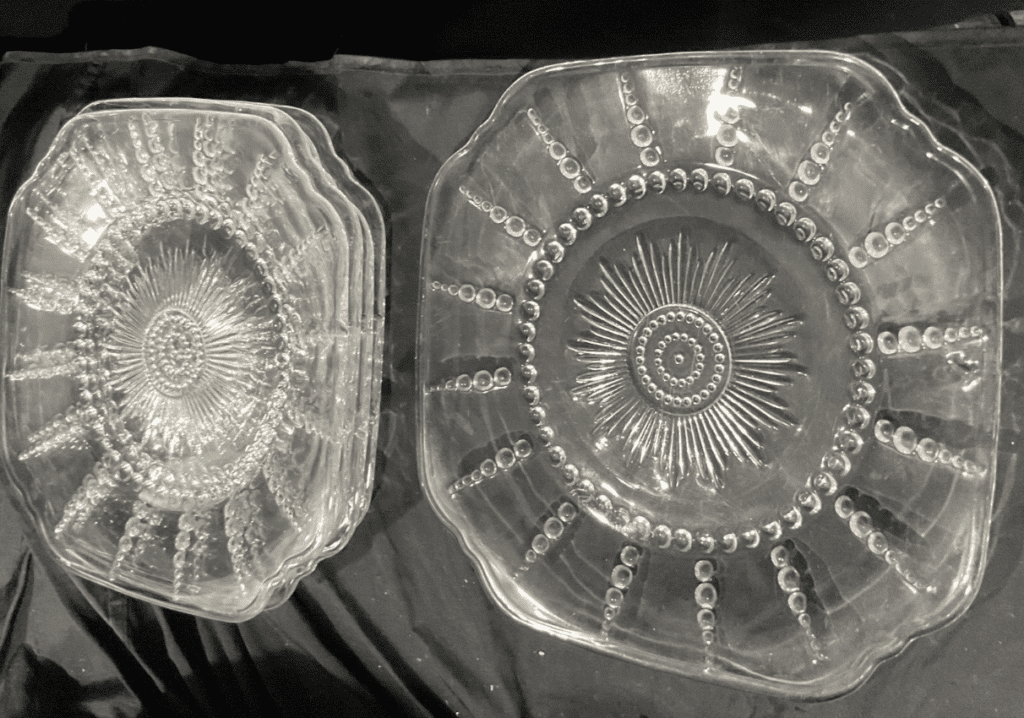
Heritage (1940 – 1955)
Since this pattern began production after 1939, it is not technically a Depression Glass pattern. However, it often gets lumped in with Federal Glass Company depression patterns, so I’m including it here for reference and identification. Heritage pattern is somewhat reminiscent of the Sandwich pattern produced by Anchor Hocking and Indiana Glass Company.
Heritage pattern features a daisy-like flower in the center, a triple leaf and flourish pattern on the rim, and dots filling up the space all around and in between.
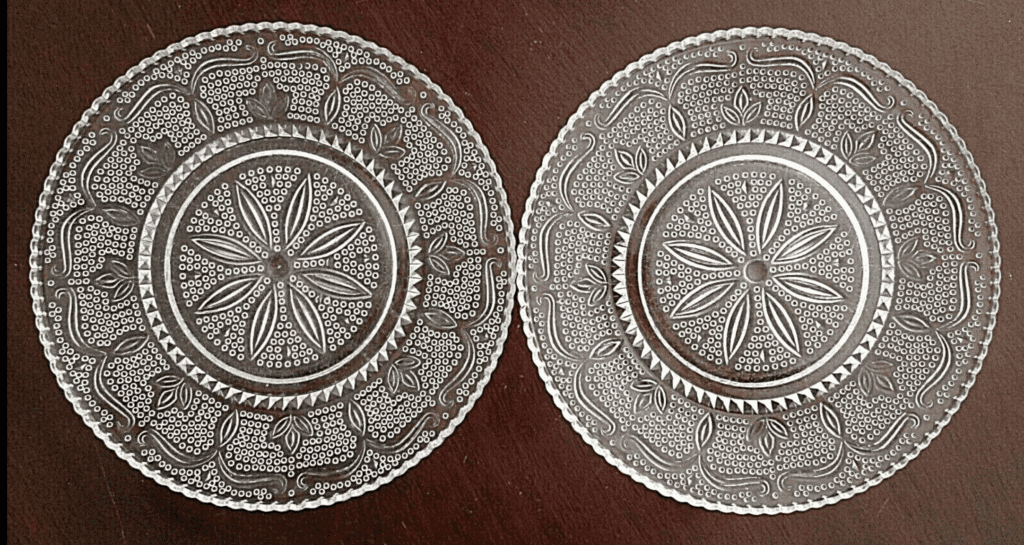
Heritage pattern was made in crystal (clear), which is the only color I’ve ever come across. However, it was also produced in pink, blue, and green. This pattern was reproduced later on and included the colors of amber and a darker green.
For more thorough reading on the history, background, and pricing of these patterns, I recommend checking out Mauzy’s Depression Glass Guide.
